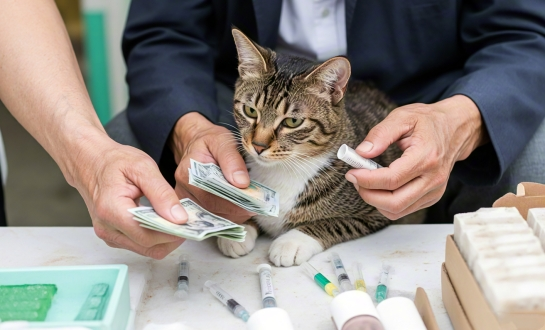Cats experiencing the early stages of FIP symptoms might exhibit alterations in their social patterns. They may become more reclusive, seeking solitude more frequently than usual.
 |
 |
 |
 |
Subtle Behavioral Changes: First Red Flags
The deadly illness known as Feline Infectious Peritonitis (FIP) strikes cats all over the globe. Faster treatment and better results may be possible if the early warning signals of GS-441524 FIP symptoms are recognised. This in-depth guide will assist both cat owners and veterinarians in recognising the mild and more noticeable FIP symptoms, allowing for early diagnosis and appropriate treatment.
|
|
|
The initial signs of FIP can be easily overlooked, as they often mimic common feline behaviors. However, astute observation may reveal some telltale changes:
One of the earliest indications of FIP is a noticeable decline in your cat's energy levels. Your typically playful feline may suddenly prefer to sleep more and engage less in their usual activities.
A gradual or sudden decrease in food intake can be an early warning sign. Cats with developing FIP may show less interest in their meals or leave food untouched.
Cats experiencing the early stages of FIP symptoms might exhibit alterations in their social patterns. They may become more reclusive, seeking solitude more frequently than usual.
 |
 |
 |
 |
As FIP progresses, more apparent physical symptoms may manifest:
A persistent fever that does not respond to conventional antibiotic treatments is one of the earliest and most common FIP symptoms observed in affected cats. This fever is often low-grade but may fluctuate or remain constant over time, indicating an ongoing inflammatory response. The immune system's struggle to combat the virus leads to this sustained elevation in body temperature. Owners might notice lethargy, reduced activity, and a general lack of energy accompanying the fever. Because the fever can mimic other infections, it is crucial to seek veterinary evaluation if it persists without an identifiable cause.
Unintended weight loss is another significant sign of FIP progression and often occurs even when a cat maintains a seemingly normal or only slightly reduced appetite. This weight loss is frequently accompanied by muscle wasting, particularly noticeable along the spine and hindquarters. The cat's body uses stored energy to fight the infection, leading to gradual but noticeable physical decline. This symptom may develop slowly over weeks or become more pronounced as the disease advances. Owners should monitor changes in body condition closely, as unexplained weight loss is often one of the most telling FIP symptoms.
In some cases, FIP affects the eyes and nervous system, leading to more severe and complex clinical manifestations. Ocular involvement might include changes in pupil size or shape, cloudiness, inflammation, or even vision loss due to uveitis or retinal detachment. Neurological signs such as ataxia (loss of coordination), tremors, behavioral changes, or seizures indicate the virus has reached the central nervous system. These advanced FIP symptoms often appear in the later stages of the disease and can significantly impact a cat's quality of life, requiring specialized veterinary care for management.
In the “wet” or effusive form of FIP, fluid accumulation within the abdominal cavity is a hallmark symptom. This buildup leads to noticeable swelling or distention of the abdomen, often accompanied by discomfort and changes in posture. The accumulated fluid can also put pressure on surrounding organs, contributing to reduced appetite, vomiting, or digestive disturbances. In severe cases, fluid may also accumulate in the chest cavity, causing breathing difficulties. This symptom is a strong indicator of advanced disease and, when combined with other FIP symptoms, should prompt immediate veterinary attention for diagnostic evaluation and supportive care.
Jaundice, or the yellowing of the skin, gums, and whites of the eyes, is a late-stage symptom that indicates liver involvement as FIP symptoms progress. The virus can trigger inflammation that impairs liver function, reducing the organ's ability to process bilirubin — a byproduct of red blood cell breakdown. As bilirubin accumulates in the blood, visible yellow discoloration appears. Jaundice is often accompanied by other signs of liver dysfunction, such as lethargy, vomiting, or changes in appetite. This symptom suggests a more severe systemic impact of the disease and typically signifies that FIP has reached an advanced, critical stage.
Recognizing when to seek veterinary care is crucial in managing potential FIP cases:
If you notice any combination of the following symptoms, consult your veterinarian immediately:
For less severe or isolated symptoms, monitor your cat closely and seek veterinary advice within 1-2 days if the following persist:
Even in the absence of symptoms, regular veterinary check-ups are essential for early detection of FIP and other feline health issues. Aim for annual or bi-annual visits, depending on your cat's age and health status.
Early detection of FIP symptoms can significantly impact the course of treatment and potential outcomes for affected cats. By staying vigilant and observant of your feline companion's behavior and physical condition, you can play a crucial role in identifying FIP in its early stages. Remember, while the symptoms discussed can be indicative of FIP, they may also be associated with other feline health issues. Always consult with a qualified veterinarian for proper diagnosis and treatment options.
Recent advancements in FIP treatment, including the development of GS-441524, have shown promising results in managing this once-fatal disease. However, early intervention remains key to increasing the chances of successful treatment.
|
|
|
A: While there's no guaranteed prevention for FIP, maintaining good hygiene, reducing stress, and ensuring a healthy diet can help support your cat's immune system, potentially reducing the risk of FIP development.
A: The virus that can mutate into FIP (feline coronavirus) is contagious, but FIP itself is not directly transmissible from cat to cat. Not all cats exposed to the coronavirus will develop FIP.
A: While FIP can affect any cat, some studies suggest that certain pedigree breeds, particularly Abyssinians, Bengals, and Ragdolls, may have a higher predisposition to developing FIP.
Early identification and treatment of FIP is of the utmost importance, and we at BLOOM TECH know this. For felines diagnosed with FIP, our top-notch GS-441524 formulation provides a glimmer of hope. Veterinarians and cat owners now have a trustworthy weapon in the battle against this difficult illness thanks to our dedication to purity and rigorous quality control procedures.
Don't wait until it's too late. Equip yourself with knowledge and the right resources to protect your feline friends. For more information on our GS-441524 product and how it can be part of your FIP management strategy, contact our team at Sales@bloomtechz.com. As a trusted GS-441524 manufacturer, we're here to support you every step of the way in ensuring the health and longevity of your beloved cats.
1. Pedersen, N.C. (2019). "Feline Infectious Peritonitis: An Update on Pathogenesis and Treatment." Journal of Feline Medicine and Surgery, 21(5), 427-440.
2. Addie, D.D. (2020). "Feline Coronavirus and Feline Infectious Peritonitis Diagnosis and Treatment." Veterinary Clinics of North America: Small Animal Practice, 50(5), 1023-1039.
3. Tasker, S. (2018). "Diagnosis of Feline Infectious Peritonitis: Update on Evidence Supporting Available Tests." Journal of Feline Medicine and Surgery, 20(3), 228-243.
4. Murphy, B.G., et al. (2021). "The Nucleoside Analog GS-441524 Strongly Inhibits Feline Infectious Peritonitis (FIP) Virus in Tissue Culture and Experimental Cat Infection Studies." Veterinary Microbiology, 252, 108872.

Echo
9 years of experience in chemical articles; Doctoral degree; Organic Chemistry major; R&D-4 Dept; Technology support; R&D engineer
Anticipating your Business & Technology support inquiry
Please send us the products that interest you, and we will provide you with one-on-one service
Recommended Blog

An International Buyer's Guide to GS-441524: From Order to Delivery
We are looking forward to your feedback and guide!
Contact UsCopyright © 2025 All rights reserved.